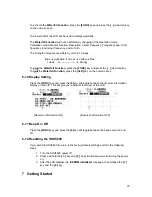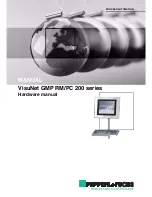
35
While monitoring a crowded band with lots of strong signals, the noise floor of the SDU5600
may rise due to the AGC action of the receiver. Overloading the receiver may cause a
distortion within the receiver’s amplifier circuits which then affects the SDU5600 noise floor.
Turn the RF attenuator ON if such situation is observed.
Frequency Resolution Band Width (RBW)
The displayed signal level may be affected depending on the choice of narrow or wide filters
as a result of different losses in each filter applied. In addition, the signals which use a wider
band width (i.e. Wide FM, TV, high speed digital signals) may also affect the displayed signal
level. When a signal of wide band width passes through a narrow filter, only partial energy
will be measured, and will result in reduced signal level on the display when compared to the
same signal measured after passing through a wide filter. Similar situations may be noticed
when the sweeping rate is too fast for the narrow filter path.
AGC
The signal level of the SDU5600 may fluctuate when the receiver is tuned or the received
signal may appear to change in level. This is because the AGC circuit of the receiver reacts to
varying incoming signals. When the receiver is tuned to a very weak signal or to a frequency
with no activity at all, the receiver’s RF gain is set to a maximum. Under such circumstances,
when a strong signal is received, the AGC reacts to reduce the input level to the SDU5600.
Some receivers have an AGC OFF position which can prevent such fluctuation. This will,
however, consequently increase the distortion / noise in audio when a strong signal is
received.
Image reception
You may find stray signals on the screen, like meteor trails or ghosts, moving in the opposite
direction to tuning or moving faster / slower randomly compared to original active signals.
Such ghost signals are the result of images or cross-modulation / inter-modulation caused
by design characteristics of the receiver.
Minimum Frequency Span
The minimum frequency span of the SDU5600 is 160 KHz. You cannot change it narrower
than 160 KHz.
9 Computer control information
Your SDU5600 is fully controllable by PC via the RS-232C interface. No specific hardware
interface is required, just a straight RS-232C cable.
The SDU5600 is equipped with an RS-232C port in addition to the connection port for a
receiver. The RS-232C port uses a DB-9 connector.
The SDU5600 RS-232C specification is as follows:
Baud rate: 9600 bps
Data bits: 8
Stop bits: 2
Parity: None
Flow control: RTS / CTS




































